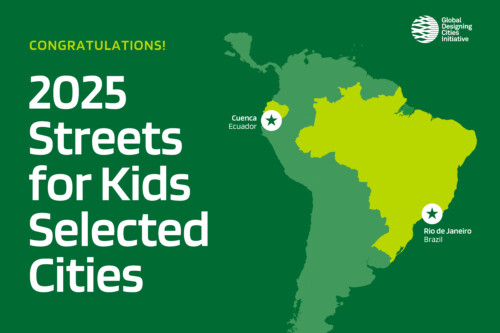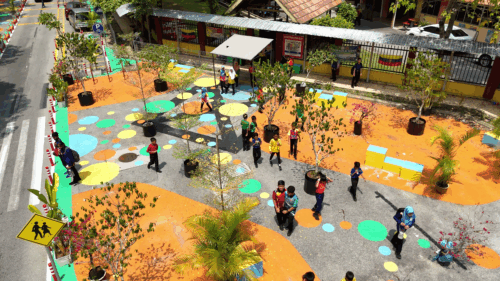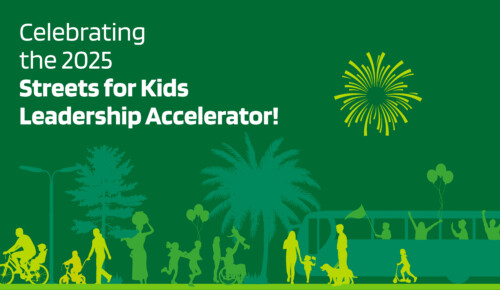
Taking place May 17-22, 2021, the theme of this year’s UN Global Road Safety Week (UNGRSW) is “Streets for Life,” focusing on the importance of limiting speeds to 30km/h (20mph) on streets where people and vehicles mix in an organized way.
Every year, road traffic crashes are responsible for the death of 1.35 million people around the world, with more than 93% of these fatalities occurring in low- to middle-income countries. We know these deaths (and tens of millions of serious injuries) are preventable, and it’s time to demand that leaders deliver 30km/h streets where people walk, live, and play.
The 2020 Stockholm Declaration, adopted by governments worldwide, calls for a focus on livable streets and a maximum road travel speed of 30 km/h where vulnerable road users and vehicles mix. This year’s week of action kicks off the Second U.N. Decade of Action for Road Safety—a 10-year window with an ambitious target to reduce road crash deaths by 50 percent.
The call is urgent because low speeds save lives. By making walking and cycling safer and more accessible, 30km streets support public health initiatives, and they are critical in the effort to reach global climate goals. Safe, low-speed streets contribute to a virtuous cycle of zero carbon active travel, shifting from car dependence, enabling thriving public transportation, cleaner air and lower CO2 emissions.
30km streets are urgent for advancing social and racial equity, as it is lower income and minority communities who are most exposed to high-speed traffic, along with the road danger, environmental hazard, and social exclusion it causes. 30km streets are also urgent for our children and youth, and vital for their wellbeing. Children are most at risk on the streets where they live, play, and travel to school. Every day 3,000 children and young people are killed or seriously injured on the world’s roads. Speed kills, and these deaths and injuries are preventable.
“We are proud to support this call to action to transform streets for life during UN Road Safety Week,” said Skye Duncan, Director of GDCI. “It is crucial that global leaders, policy-makers, and practitioners act urgently to reduce vehicular speeds, helping to deliver accessible streets and mobility choices that are safe for everyone, everywhere. The decisions we make now can literally be the difference between life and death.”
NACTO-GDCI calls on our community and network of organizations, planning and transportation professionals, engineers, and advocates to join the fight for low-speed streets worldwide.
Here are some ways you can get involved now:
- Read & sign the open letter to help deliver a united message to world leaders in advance of the 2022 high-level road safety meeting
- Explore the Streets for Life Toolkit, so you can help spread the message to your network
- Learn about key myths & facts surrounding 30km/h streets, so you’re equipped to tackle misconceptions and make your case
- Endorse NACTO-GDCI’s Global Street Design Guide. Endorsing the GSDG communicates a message to your citizens, colleagues, and partners that you are committed to advancing safe, healthy, sustainable, and vibrant streets using evidence-based and people-first design strategies.
Free Resources from iRAP and NACTO-GDCI
NACTO-GDCI has collaborated with the International Road Assessment Programme (iRAP) to provide additional resources during Road Safety Week to promote the safety, health, economic, and environmental benefits of lower speeds around the world. We are excited to announce that the jointly-produced resource, iRAP Star Ratings of NACTO-GDCI’s Global Street Design Guide, is now available for free download in French, Portuguese, and Spanish!

The iRAP Star Ratings of NACTO-GDCI’s Global Street Design Guide is a valuable resource for designing safe streets in your community, helping to save lives and improve sustainable mobility for all road users.
High quality road design takes the needs of all road users into account. This supplement to the Global Street Design Guide—which gives the iRAP Star Rating for the existing and improved designs—will allow road designers everywhere to understand the scale of the safety benefit that good road design can deliver. This resource, free to all, will provide ideas to those wanting to make safety upgrades to their streets, and will help those making upgrades understand the safety benefits.
Download pdf here
Baixe em portugues
Descarga en español
Téléchargez en français
In collaboration with iRAP, we have also developed the following animations to emphasize how lower speeds on streets around the world protect people and enable healthy, more sustainable choices such as walking and cycling. The animations capture three street typologies from the iRAP Star Ratings of the Global Street Design Guide:
Animation of a 24 m Residential Street (as seen on pages 37-38)
Animation of a 30 m Neighborhood Main Street (as seen on pages 43-44)
Animation of a 18 m Central One-Way Street (as seen on pages 45-46)
Streets belong to all of us. Low-speed streets save lives.










